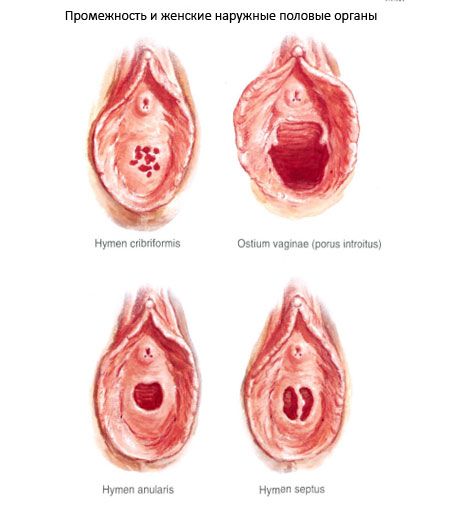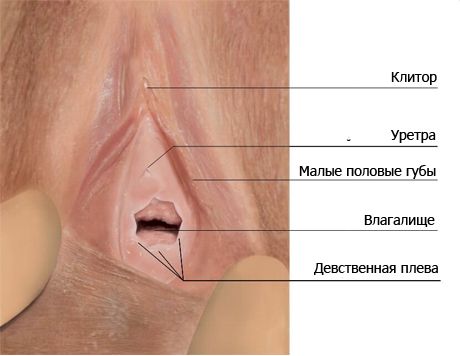
All iLive content is medically reviewed or fact checked to ensure as much factual accuracy as possible.
We have strict sourcing guidelines and only link to reputable media sites, academic research institutions and, whenever possible, medically peer reviewed studies. Note that the numbers in parentheses ([1], [2], etc.) are clickable links to these studies.
If you feel that any of our content is inaccurate, out-of-date, or otherwise questionable, please select it and press Ctrl + Enter.
Hymen
Medical expert of the article
Last reviewed: 04.07.2025

The hymen is a crescent-shaped or perforated connective tissue plate that covers the opening of the vagina in girls and serves as a barrier between the external and internal organs of the female reproductive system. The hymen is rich in capillaries and nerve endings.
Read also:
- Pain after losing virginity
- Virginity can be restored without surgery
- The Hymen: What Men Need to Know
- Who experiences pain during defloration?
- How to avoid pain during defloration?
The hymen is found in mammals such as chimpanzees, humans, horses, elephants and whales.
During the first sexual intercourse, the hymen usually ruptures, and its remnants take the form of hymenal flaps (carunculae hymenales). The process of losing virginity is called defloration. There is also traumatic defloration, in which the loss of virginity occurs as a result of some trauma not related to sexual intercourse.
Sometimes there may be a congenital absence of the hymen. After the rupture of the hymen, it may become closed - secondary atresia.
The hymen is considered the only female organ that does not change in size from the moment of birth. Based on the shape and number of its openings, the hymen can be: annular (with one opening in the middle); there are also crescent-shaped, tubular, labial, keel-shaped, and roller-shaped. During the first sexual intercourse, during defloration, the hymen most often ruptures and only the hymenal papillae remain. With a strong hymen, false vaginismus may occur.

Usually female virginity assumes the anatomical integrity of the hymen. But the following variants are possible: due to anatomical distinctive features and elasticity, the hymen can remain intact, including after several sexual acts, at the same time it can be damaged, for example, by special devices during a gynecological examination, or as a result of an injury, active participation in certain sports. Male virginity does not have any anatomical features and a virgin is considered a representative of the stronger sex who has not had hetero- or homosexual sexual contacts.

Physiological purpose of the hymen
The hymen performs a rather utilitarian function in the female - or rather, in the girl's - body. It plays the same role as the lips of the oral cavity: it serves as a barrier between the external and internal environment (in this case - the vagina). Unfortunately, the thin film in the girl's body, created to protect the delicate creature from infections, in fact began to play a fateful role in the lives of women.
The moral significance of the hymen
In different historical periods, the moral meaning of virginity was different. In some nations that were at the primitive stage of development, a long state of virginity was assessed as sexual unattractiveness of a young woman. In Ancient Greece, for example, it was common for a girl of 4-5 years to take part in sexual games of young people or even adults. The concept of virginity existed exclusively for the Vestals - priestesses of the goddess of the family hearth Vesta. A Vestal who lost her virginity was buried alive. For all other girls, sexual liberation was an absolutely routine concept and no one was embarrassed by the very early onset of sexual activity by today's standards. During the reign of Emperor Tiberius (1st century AD), the law did not allow punishing a virgin. Before the execution, the executioner had to deprive her of her innocence. In the pre-Christian period, when prostitution was very widespread, the object of sacrifice was considered a virgin and often it was a virgin who was sacrificed to the Almighty. In the customs of initiation, the loss of virginity was traditionally carried out by a non-sexual method using an artificial penis.
According to ethnic superstitions in almost all European countries, virginity is personified by an unblown rosebud, which a woman either proudly holds or covers herself with, protecting herself with it. In Holland, a wife who remained a virgin before marriage wore an apron with a rosebud woven or embroidered on her clothes. The Koran promises a devout Muslim 10,000 virgins in paradise, who after each night will miraculously regain their virginity. At the beginning of the 19th century, a virgin in London cost 100 pounds sterling. In the Land of the Rising Sun, 3 to 4 thousand operations are performed annually to restore the hymen. To this day, 80% of Japanese insist that their wives be immaculate.
But the hymen has long been valued not as a method of maintaining women's health. As is known, for almost all nations, preserving virginity was an integral condition for a young woman to marry. To such an extent that the bloody sheet after the first wedding night was proudly shown to everyone, and girls who lost their virginity prematurely were punished by their own brothers, uncles or fathers.
Использованная литература


 [
[